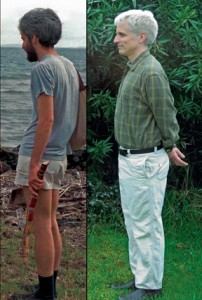 Observe the posture of the figures painted by Bryan Larson. His figures have relatively straight backs and necks, with shoulders rolled back rather than forward. They project self-confidence and an eagerness to achieve and live.
Observe the posture of the figures painted by Bryan Larson. His figures have relatively straight backs and necks, with shoulders rolled back rather than forward. They project self-confidence and an eagerness to achieve and live.
That sort of posture was common in early America (and remains common in parts of the world). But then something changed. Posture expert Esther Gokhale writes in her book, 8 Steps to a Pain-Free Back: “[A]fter the 1920’s, people began to thrust their pelvises and necks forward, and hunch or round their shoulders. It became fashionable to slouch.”
Although Gokhale is concerned primarily with the health ramifications of posture, her work also offers some fascinating cultural and psychological insights. In addition to observing cultural changes regarding posture, she suggests (in a Google talk) that tucking one’s pelvis is akin to an animal tucking its tail in fear.
In discussing dance in The Romantic Manifesto, Ayn Rand draws a connection between one’s sense of life and one’s posture:
Every strong emotion has a kinesthetic element, experienced as an impulse to leap or cringe or stamp one’s foot, etc. Just as a man’s sense of life is part of all his emotions, so it is part of all his movements and determines his manner of using his body: his posture, his gestures, his way of walking, etc. We can observe a different sense of life in a man who characteristically stands straight, walks fast, gestures decisively—and in a man who characteristically slumps, shuffles heavily, gestures limply.
Of course it would be a mistake to judge a person’s mental state based solely on his posture; many other things can influence posture, including illness, physical debility, mood, and habit. It is also possible for a rotten person to possess good posture. Nevertheless, in important ways, posture relates to state of mind, and a self-confident demeanor tends to manifest in a self-confident posture.
 An interesting implication of Gokhale’s work is that one’s posture can also impact one’s state of mind. Good posture can, among other things, lessen pain and increase mobility, and thereby improve one’s mental disposition.
An interesting implication of Gokhale’s work is that one’s posture can also impact one’s state of mind. Good posture can, among other things, lessen pain and increase mobility, and thereby improve one’s mental disposition.
Obviously good posture alone cannot resolve emotional problems, but paying attention to one’s body, standing erect, holding one’s head high, and the like undoubtedly contribute to one’s mental well-being. Thus, for physical and mental health, it makes sense to develop a posture of self-esteem.
Like this post? Join our mailing list to receive our weekly digest. And for in-depth commentary from an Objectivist perspective, subscribe to our quarterly journal, The Objective Standard.
Related:
Image: Gokhale Method


![[TEST] The Objective Standard](https://test.theobjectivestandard.com/wp-content/uploads/2017/10/logo.png)











